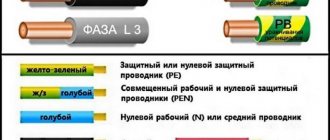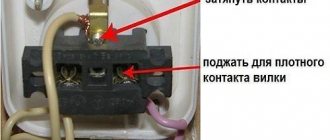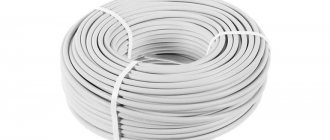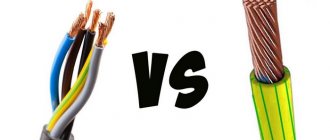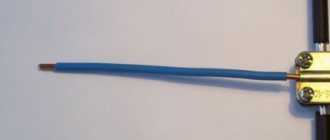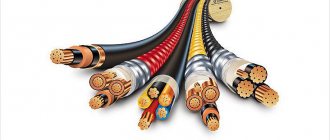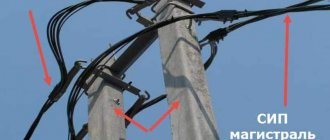4.2 / 5 ( 5 votes)
In this article I will tell you how to choose the right cable cross-section for your home or apartment. If the electrical panel is the “heart” of our power supply system, then the cables connected to the electrical panel circuit breakers are the “blood vessels” that supply electricity to our household electrical receivers.
Instagram https://instagram.com/elektroschyt VKontakte https://vk.com/elektrika46
When installing electrical wiring in a house or apartment, all stages, starting from designing the power supply system, installing automatic devices, ouzo, difavtomats in the electrical panel and ending with the final installation of sockets or switches, must be approached with full responsibility, because your personal electrical safety depends on this, and also the fire safety of your home or apartment. Therefore, we approach the choice of cable cross-section with all seriousness, because no other method of transmitting electricity in a private house or apartment has yet been invented.
It is important to choose the correct cable cross-section, specifically for a specific line (group) of electrical receivers. Otherwise, if we choose an undersized cable cross-section, this will lead to overheating, destruction of the insulation and further to a fire ; if you touch a cable with damaged insulation, you will receive an electric shock. If you choose a cable cross-section that is too high for a house or apartment, this will lead to increased costs, and difficulties will arise during the electrical installation of cable lines, because the larger the cable cross-section, the more difficult it is to work with it; not every socket will “fit” a cable with a cross-section of 4 sq. mm .
I provide a general universal table , which I myself use to select the rated current of circuit breakers for protecting cable lines.
I won’t fill your head with abstruse formulas for calculating cable cross-sections from books on electrical engineering, so that you can choose the right cable cross-section. Everything has long been calculated and tabulated.
Please note that with different methods of installing electrical wiring (hidden or open) , cables with the same cross-section have different long-term permissible currents.
Those. with an open method of installing electrical wiring, the cable heats up less due to better cooling. With a closed method of installing electrical wiring (in grooves, pipes, etc.), on the contrary, it heats up more. This is an important point, because if you choose the wrong machine for cable protection, the rating of the machine may turn out to be overestimated relative to the long-term permissible current of the cable, from - why the cable can become very hot, but the machine will not turn off.
Introduction
A cable is a wire covered with insulation that serves to transmit electricity from a source to a consumer. Today's market is ready to offer customers many types of similar wires: aluminum, copper, single-core, multi-core, single- and double-insulated, with a cross-section from 0.35 mm2 to 25 mm2 or more. But most often, to connect household consumers, cables with a thickness of 0.5 to 6 square meters are used - this is quite enough to power any equipment.
Classic cable for wiring in an apartment
Why is it necessary to select insulated conductors, and not buy the first one you come across? The thing is that the thickness of the conductor determines the current strength it can withstand. For example, the permissible current for copper wires 1 mm thick is up to 8 Amperes, aluminum – up to 6 Amps.
Why not just buy the thickest wire possible? Because the thicker it is, the more expensive it is. In addition, a thick cable needs to be hidden somewhere, a groove must be cut for it in the ceiling and walls, and holes must be made in the partitions. In a word, there is no point in overpaying, because you won’t be driving a KAMAZ to buy bread.
If you choose a wire with a smaller diameter, it simply cannot withstand the current passing through it and will begin to heat up. This leads to insulation melting, short circuit and fire. Therefore, you should never rush when choosing a high-quality cable for connecting any devices - first think about what exactly will work on the new line, and then choose the thickness and type of cable.
Conductor markings (wire diameter)
If the cross-section coincides with that indicated on the tag, great, you can safely take it. But when the resulting result is much less, you should opt for a more powerful cable that has the next best parameters. Otherwise, you can look for wires in other stores. Unfortunately, high-quality goods that meet GOST standards are not so easy to come by these days. Remember that a high-quality cable will not be cheap. The conclusion follows from this: if you want to get a quality product, look for trusted stores with markings that comply with GOST.
Before making a final decision - to take or not to take the wire, it is necessary to inspect the insulation very carefully. The plastic shell of the core must be continuous, have an impressive thickness, which will be the same along the entire length. If, in addition to discrepancies in diameter, negative nuances with the braid are also revealed, then of course you need to look for another store where the cable would be purchased elsewhere and from a completely different manufacturer. It's better not to take risks with electricity.
Therefore, it is better to overpay, perhaps spend more time searching, but buy a high-quality conductor made according to GOST, and not made according to specifications. In this case, you can guarantee that the cable will serve the time stated in the documents without any problems, and, most likely, much longer. The choice of wires is a very serious matter, and it certainly cannot be handled carelessly. You should not risk the building just to reduce the search time or save extra pennies.
How to calculate the power of devices
First, let's look at the option of choosing a cable cross-section based on the power of the devices connected to it. How to count correctly?
Think about which devices will be powered by a particular cable. If you pull it into the hall, then a TV, computer, vacuum cleaner, audio system, set-top box, hair dryer, floor lamp, aquarium lighting or other household appliances can simultaneously operate from the outlet in the room. Add up the power of all these devices and multiply the resulting value by 0.8 to get the real figure. Indeed, it is unlikely that you will use them all at the same time, so 0.8 is a reduction factor that will allow you to adequately estimate the total load.
If you are counting for the kitchen, then add up the power of an electric kettle, electric oven and hob, microwave, dishwasher, toaster, bread maker and other available/planned appliances. The kitchen usually consumes the most energy, so it should have either two cables with separate circuit breakers, or one powerful one.
So, to calculate the total power of all devices, you need to use the formula Ptotal = (P1+P2+...+Pn)*0.8, where P is the power of a specific consumer connected to the outlet.
Copper wires are better for wiring and can withstand greater loads
Defining a section using a ruler
An economical and accurate method is to determine the cross-section of cables and wires using an ordinary ruler. In addition to this, you will need a simple pencil and the wire itself. To do this, the wire core is stripped of insulation and then tightly wound onto a pencil. After this, the total length of the winding is measured using a ruler.
The resulting measurement result must be divided by the number of turns. The result is the diameter of the wire, which will be needed for subsequent calculations. The cable cross-section is determined by the previous formula. To obtain more accurate results, there should be as many wound turns as possible, but not less than 15. The turns are pressed tightly together, since free space contributes to a significant increase in the error in calculations. The error can be reduced by using a large number of measurements taken in different versions.
Choosing thickness
Once you have determined the power, you can select the cable thickness. Below we will provide a table of wire cross-sections by power and current for a classic copper wire, since aluminum wires are no longer used for wiring today.
| Cable cross-section, mm | For 220 V | For 380 V | ||
| current, A | power, kWt | current, A | power, kWt | |
| 1,5 | until 17 | 4 | 16 | 10 |
| 2,5 | 26 | 5,5 | 25 | 16 |
| 4 | 37 | 8,2 | 30 | 20 |
| 6 | 45 | 10 | 40 | 25 |
| 10 | 68 | 15 | 50 | 32 |
| 16 | 85 | 18 | 75 | 48 |
Attention:
When choosing, keep in mind that most Russian manufacturers save on material, and a 4 mm2 cable may actually end up being 2.5 mm2. Practice shows that such “savings” can reach 40%, so be sure to either measure the cable diameter yourself or purchase it with a reserve.
Now let's look at an example of calculating the wire cross-section based on power consumption. So, we have an abstract kitchen, the power of the appliances is 6 kW. We multiply this figure 6*0.8=4.8 kW. The apartment uses one phase, 220 volts. The closest value (you can only take it as a plus) is 5.5 kW, that is, a cable 2.5 square meters thick. Just in case, we have a reserve of 0.7 kW, which “smoothes out” the savings for producers.
It should also be borne in mind that if the wire is working at its limit, it will heat up quickly. Due to heating to 60-80 degrees, the maximum current is reduced by 10-20 percent, which leads to overload and short circuit. Therefore, for critical sections of the chain, an increased coefficient should be used, multiplying the value not by 0.8, but by 1.2-1.3.
Correct calculation of cable thickness is the key to its long service life
Most often, copper structures with a thickness of 1.5 squares are used for laying lighting systems, for sockets - 2.5 squares, for powerful consumers - 4 or 6 squares (machines are installed at 16, 25, 35 and 45A, respectively). But this use is only suitable for standard apartments or houses that do not have powerful consumers. If you have an electric boiler, boiler, oven or other appliances that consume more than 4 kW, then you need to calculate the cables for each specific case, and not use general recommendations.
The above table of cable cross-sections for power and current uses limit values, so if you get calculated numbers that overlap with encyclopedic ones, then try to take the cable with a reserve. For example, if our kitchen had a power of 7 kW, then 7 * 0.8 = 5.6 kW, which is greater than the value of 5.5 for a 2.5 square cable. Take a cable of 4 squares with a reserve or divide the kitchen into two zones by connecting two 2.5 mm2 cables.
Cable 6 squares – range, delivery, benefits
The online store “World of Electrics” has been selling a huge range of electrical goods for more than 15 years. A wide selection allows you to immediately select the desired 6 kV cable. mm, both made in accordance with GOST and the factories’ own technical specifications, or order an electrical cable of 6 squares of rare brands with guaranteed delivery to the warehouse within 1–3 days.
You can buy a cable at the best price per meter with additional discounts and receive it within 24 hours from World of Electrics. We quickly process applications and send goods for delivery throughout the capital and region today if the order is received before noon. A polite courier service driver will deliver the order and provide comprehensive information about the features of operation and installation. It is also possible to send products by logistics companies in Moscow, Moscow Region and to the regions.
What to do with the length
If you are counting cables in an apartment or small house, then you don’t have to make any adjustments to the cable length at all - it’s unlikely that you will have branches 100 meters or more in length. But if you are laying wiring in a large multi-story cottage or shopping center, then you must take into account possible losses along the length. Usually they are 5 percent, but it is more correct to calculate them using a table and formulas.
So, the load moment is calculated as the product of the length of your wire and the total power consumption. That is, the length of your cable is calculated as the product of the cable length in meters and the power in kilowatts.
In the table below we see how losses depend on the cross-section of the conductor. For example, a cable with a thickness of 2.5 mm2 with a load of up to 3 kW and a length of 30 meters has a loss of 30x3 = 90, that is, 3%. If the loss level exceeds 5%, then it is recommended to choose a thicker cable - there is no need to skimp on your safety.
| U, % | Load moment, kW*m | |||||
| 1,5 | 2,5 | 4 | 6 | 10 | 16 | |
| 1 | 18 | 30 | 48 | 72 | 120 | 192 |
| 2 | 36 | 60 | 96 | 144 | 240 | 384 |
| 3 | 54 | 90 | 144 | 216 | 360 | 575 |
| 4 | 72 | 120 | 192 | 288 | 480 | 768 |
| 5 | 90 | 150 | 240 | 360 | 600 | 960 |
This table of loads by cable cross-section is valid for a single-phase network. Three-phase is characterized by an average increase in load size of six times. The value increases three times due to distribution over three phases, and two times due to the neutral conductor. If the load on the phases is uneven (there are strong distortions), then losses and loads increase greatly.
Correct connection of machines with copper cable
You should also consider which consumers will be connected to your wire. If you plan to connect halogen low-voltage lamps, then try to place them as close to the transformers as possible. Why? Because if the voltage drops by 3 volts at 220 volts, we simply won’t notice, and if the voltage drops by the same 3 volts at 12 volts, the lamps simply won’t light up.
If you select the wire cross-section according to the current for an aluminum cable, then keep in mind that the resistance of the material is 1.7 times higher than that of copper. Accordingly, losses in them will be greater by the same 1.7 times.
Load (wire diameter)
Calculation of the cross-section of cable products based on current load must be carried out to further protect them from overheating. If too much electric current passes through the conductors for their cross-section, destruction and melting of the insulating layer may occur. The maximum permissible long-term current load is the quantitative value of the electric current that can pass the cable for a long time without overheating. It's important to know this. To determine this indicator, it is initially necessary to sum up the powers of all energy consumers. After this, calculate the load using the formulas:
I = P∑*Ki/U (single-phase network),
I = P∑*Kи/(√3*U) (three-phase network),
Where:
- P∑ – total power of energy consumers;
- Ki – coefficient equal to 0.75;
- U – electrical voltage in the network.

